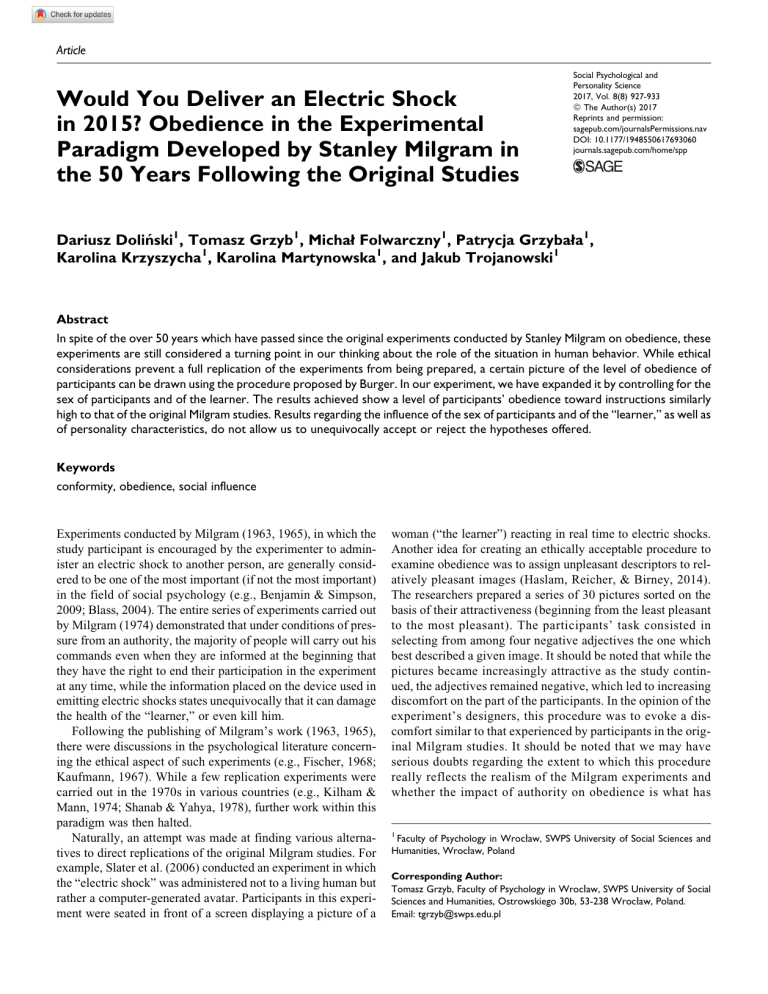
Article Would You Deliver an Electric Shock in 2015? Obedience in the Experimental Paradigm Developed by Stanley Milgram in the 50 Years Following the Original Studies Social Psychological and Personality Science 2017, Vol. 8(8) 927-933 ª The Author(s) 2017 Reprints and permission: sagepub.com/journalsPermissions.nav DOI: 10.1177/1948550617693060 journals.sagepub.com/home/spp Dariusz Doliński1, Tomasz Grzyb1, Michał Folwarczny1, Patrycja Grzybała1, Karolina Krzyszycha1, Karolina Martynowska1, and Jakub Trojanowski1 Abstract In spite of the over 50 years which have passed since the original experiments conducted by Stanley Milgram on obedience, these experiments are still considered a turning point in our thinking about the role of the situation in human behavior. While ethical considerations prevent a full replication of the experiments from being prepared, a certain picture of the level of obedience of participants can be drawn using the procedure proposed by Burger. In our experiment, we have expanded it by controlling for the sex of participants and of the learner. The results achieved show a level of participants’ obedience toward instructions similarly high to that of the original Milgram studies. Results regarding the influence of the sex of participants and of the “learner,” as well as of personality characteristics, do not allow us to unequivocally accept or reject the hypotheses offered. Keywords conformity, obedience, social influence Experiments conducted by Milgram (1963, 1965), in which the study participant is encouraged by the experimenter to administer an electric shock to another person, are generally considered to be one of the most important (if not the most important) in the field of social psychology (e.g., Benjamin & Simpson, 2009; Blass, 2004). The entire series of experiments carried out by Milgram (1974) demonstrated that under conditions of pressure from an authority, the majority of people will carry out his commands even when they are informed at the beginning that they have the right to end their participation in the experiment at any time, while the information placed on the device used in emitting electric shocks states unequivocally that it can damage the health of the “learner,” or even kill him. Following the publishing of Milgram’s work (1963, 1965), there were discussions in the psychological literature concerning the ethical aspect of such experiments (e.g., Fischer, 1968; Kaufmann, 1967). While a few replication experiments were carried out in the 1970s in various countries (e.g., Kilham & Mann, 1974; Shanab & Yahya, 1978), further work within this paradigm was then halted. Naturally, an attempt was made at finding various alternatives to direct replications of the original Milgram studies. For example, Slater et al. (2006) conducted an experiment in which the “electric shock” was administered not to a living human but rather a computer-generated avatar. Participants in this experiment were seated in front of a screen displaying a picture of a woman (“the learner”) reacting in real time to electric shocks. Another idea for creating an ethically acceptable procedure to examine obedience was to assign unpleasant descriptors to relatively pleasant images (Haslam, Reicher, & Birney, 2014). The researchers prepared a series of 30 pictures sorted on the basis of their attractiveness (beginning from the least pleasant to the most pleasant). The participants’ task consisted in selecting from among four negative adjectives the one which best described a given image. It should be noted that while the pictures became increasingly attractive as the study continued, the adjectives remained negative, which led to increasing discomfort on the part of the participants. In the opinion of the experiment’s designers, this procedure was to evoke a discomfort similar to that experienced by participants in the original Milgram studies. It should be noted that we may have serious doubts regarding the extent to which this procedure really reflects the realism of the Milgram experiments and whether the impact of authority on obedience is what has 1 Faculty of Psychology in Wrocław, SWPS University of Social Sciences and Humanities, Wrocław, Poland Corresponding Author: Tomasz Grzyb, Faculty of Psychology in Wrocław, SWPS University of Social Sciences and Humanities, Ostrowskiego 30b, 53-238 Wrocław, Poland. Email: tgrzyb@swps.edu.pl 928 essentially been tested here. One thing is certain: Since the original experiments by Stanley Milgram, we have yet to find a successful way of reconciling realism with care for the well-being of study participants. A few years ago, however, Burger (2009) noted that in the original studies by Milgram, a decisive majority of people who pressed the 10th button (33 people of 40) could then be convinced to press all of the remaining ones (26 people of 33). He thus arrived at the conclusion that conducting an experiment in which participants would be encouraged only to press 10 successive (and not 30 successive) buttons would, on the one hand, significantly reduce their level of discomfort, while on the other it would allow for a direct comparison of obedience in pressing the 10th button and, indirectly, that is through performing an appropriate estimate and comparison of total obedience. Burger asked himself the question of what level of obedience would be recorded in the United States almost a half-century after the Milgram experiments. He thus replicated Experiment No. 5 in which the alleged learner reports heart problems at the beginning of the experiment, and before the 10th shock is administered he demands the halting of the experiment, again reminding those present of his health problems. It turned out that 70% of Americans could be induced to press the 10th button, which led Burger (2009) to the conclusion that “average Americans react to this laboratory situation today much the way they did 45 years ago” (p. 9). In our study, we decided to apply the empirical scheme of Milgram (1974), Experiment 2 with Burger’s (2009) idea of using only 10 buttons. It is worth emphasizing that Milgram noted almost identical reactions by the participants in Experiments No. 2 and No. 5 (the 10th button was pressed by 34 of 40 in Experiment 2, and 33 of 40 in Experiment 5, and while button 30 was pressed by 25 participants in Experiment 2, and 26 in Experiment 5). Experiment 5 has been more frequently replicated around the world than Experiment 2, but for the sole reason that it is more spectacular and its results are more shocking. From the perspective of estimating obedience levels, both paradigms are, however, equally valid, while ethical considerations argue for the choice of Experiment 2 in which people are not encouraged to administer an electric shock to an individual suffering from heart problems and who demands that his participation in the experiment be concluded. Our objective was to examine how high a level of obedience we would encounter among residents of Poland. It should be emphasized that tests in the Milgram paradigm have never been conducted in Central Europe. The unique history of the countries in the region made the issue of obedience toward authority seems exceptionally interesting to us. After World War II, which began with Germany’s attack on Poland in 1939 and concluded in 1945, the countries located in Eastern Europe were made dependent on the Soviet Union, while the communist system was forced on them. One of the foundations of that system was significant curbs on democracy and the demand of strict obedience to authority. The official press used censorship to develop an impression of the authorities’ infallibility and moral legitimacy to ruling through the use of orders and Social Psychological and Personality Science 8(8) decrees. The primary and secondary school curricula also marginalized the role of such ideas as individual freedom and the right to decide about one’s own affairs (Hodos, 1999; Naimark & Gibianskii, 1997). However, the year 1989 marked a sea change for the entire region. The understanding reached by the communist authorities and anticommunist opposition initiated a rapid series of changes across all of Eastern Europe. Free press, democratic elections, and free speech became the norm (Petersen, 2001; Rothschild and Wingfield, 2007). However, in recent years we have observed a surge in the popularity of the political party named “Law and Justice” [Pol.: “Prawo i Sprawiedliwość”], which won an absolute majority in the last parliamentary elections. In both the verbal arena and in its actions, this party values governing with a strong hand rather than freedom and democracy. Its efforts to limit the role of democratic institutions and eliminate pluralism in the media have met with extensive social approval (public opinion polls show this party with support remaining stable at over 30%). This all means that both the historical experiences of Poles and the current political situation may have a complicated and opaque impact on obedience levels. By the same toke, we felt it would be interesting to replicate the Milgram experiment in this country. Besides, we also took advantage of introducing a factor into the experimental design that had previously never been tested to a satisfactory extent. Discussion of Milgram’s experiments in the psychological literature generally oscillates around consternation at the universal nature of people’s pliability. For example, emphasis is placed on the fact that the sex of participants in experiments on obedience is not a factor that differentiates their reactions (see Blass, 1991, for review). When considering the role of sex in experiments carried out in the Milgram paradigm, we turned our attention to something entirely different. However, before we say what that was, let us take a look at three typical descriptions of Milgram’s experiment that can be found in the psychological literature. 1. 2. 3. “Participants sat in front of an imposing shock generator and were instructed to administer an electric shocks to the learner for each incorrect answer” (Burger, 2009, p. 1). “Who among us was not surprised and sobered to learn that 65% of his subjects delivered the full series of painful and escalating shocks to an innocent partner?” (Gilbert, 1981, p. 690). “First, of course, is the unexpected enormity of the basic findings themselves—that 65% of a sample of average American adult men were willing to punish another person with increasingly higher voltages of electric shock” (Blass, 1991, p. 398). We have no doubt that the intention of these and other authors writing about experiments on obedience toward authority is not to present a false picture of reality, but it is worth noting that the confederate is defined here using words which Doliński et al. are devoid of biological sex (learner, “partner,” and “person”); meanwhile, in nearly all studies on obedience carried out under the Milgram paradigm the learner who was allegedly being electrified was a man. Existing empirical data thus demonstrates that study participants are inclined to administer a shock to a man sitting behind a wall. However, it is not clear whether the behavior of participants would change in conditions in which the experimenter instructed them to give the shock to a woman. Why do we think that the sex of the learner in experiments performed in the Milgram paradigm may be significant? Because women are physically weaker and more susceptible to physical violence than men, in accordance with cultural norms they should be treated more favorably and gently than men (Anderson, 2000; Muller-Funk, 2012). This assumption is supported in the results of meta-analyses of experiments regarding altruism, which show that women receive assistance from others more often than men (Eagly & Crowley, 1986; Piliavin & Unger, 1985), as well as meta-analyses of experiments concerning aggression, which show that it is more prevalent in conditions where its target is a man than when aggression should be directed at a woman (Eagly & Steffen, 1986). It could be assumed that results will be similar in the case of experiments carried out in the Milgram paradigm. Administering an electric shock is an obvious violation of the norm to refrain from harming an innocent person. Shocking a woman with electricity, however, is also an infringement of the norm to treat people with greater leniency who belong to vulnerable groups. It is therefore a more urgent violation of cultural norms than shocking a man with electricity. We also think that the sex of the learner will be of particular significance when the participants are males. Traditional European and North American norms (collectively “Western”) assume that men are obliged to behave nobly toward women, and thus to avoid causing them harm, both in word and in deed (Genovese, 2000; Girouard, 1981). On the other hand, in some milieus there are cultural norms which hold that men should treat women as their inferiors and require obedience and pliancy (Crowell & Burges, 1996; Fontes & McCloskey, 2011). This, in turn, would mean that male participants in an experiment conducted within the Milgram paradigm would not have any problem with administering an electric shock to a woman who made a mistake in answering. The issue of the learner’s sex as a determinant of obedience is complex and warrants empirical study. Meanwhile, we are aware of only three experiments in which the learner was a woman. In the first one (Constanzo, 1976), sex of the learner was manipulated. No evidence was obtained for the influence of this factor on the level of obedience. However, this study was never published, the experiment was conducted four decades ago, the procedure employed was significantly modified from the original one as applied by Milgram, and the cohort of participants consisted exclusively of university students, which may also have known one another. In the study by Shanab and Yahya (1977), the participant and the learner 929 were always of the same sex, which did not allow for a determination of whether the sex of the person to be zapped with electricity influences the obedience of participants. In the study by Slater et al. (2006), participants were asked to put on 3-D stereo glasses and then instructed to administer a shock to a virtual woman appearing on the screen. The absence in the study design of conditions in which the learner was a virtual man also prevented evaluation of the role played by the sex of the person inflicting pain (albeit virtual) in the degree of obedience. The issue of the role that the student’s sex may play remains therefore an open question, requiring empirical exploration. In our experiment, we decided to include 80 participants (40 of each sex). For an experiment performed within the Milgram paradigm, this is an exceptionally large number. However, we are aware that it may also be too small for a definitive understanding of the role played in obedience toward authority by sex of the participant and the sex of the learner. Procedure Participants were offered Polish złoty (PLN) 50 (equivalent to around US$15) for about an hour’s time participating in psychological research “dedicated to memory and learning.” They were recruited in one of two ways. Some of them were approached on the street, near the university. Others were acquired with the help of students of the university, who recruited participants from among their acquaintances who were not students of that institution. Those eliminated from the selection procedure were individuals who had taken a psychology course as students, as well as those who responded to a question about familiarity with psychological experiments in a manner indicating they may have come across a description of the Milgram studies. People who had ever sought the assistance of a psychiatrist or psychologist, who had experienced some trauma, and those who had episodes of alcohol or drug abuse in their history were all eliminated. The age of participants ranged from 18 to 69 with M ¼ 27.36 (standard deviation ¼ 11.07). After arriving to the psychological laboratory of the university, participants and the confederate (the latter pretending to be a participant) completed two or three questionnaires.1 Subsequently, the experimenter explained that the study would address the impact of punishments on learning and memory processes and required a division into the roles of learner and teacher. He gave the participants PLN 50 for their participation in the experiment, and then requested that they draw lots for their role by selecting one of two pieces of paper. Each of them contained the word “teacher,” but the confederate (a man or a woman depending on the experimental conditions) announced that he or she had selected the paper with the word learner. The experimenter asked the participants to sign an informed consent form for participation in the experiment. The form stated that the participant could interrupt participation in the study at any moment. The experimenter additionally emphasized that any decision to do so would not require the return of the compensation paid for participation. The trio then proceeded to the 930 laboratory, where the experimenter showed the generator (identical in appearance to the one used by Milgram) and explained that the learner’s role would consist in learning by heart associations between certain syllables, and then handed the learner a piece of paper containing eight pairs of syllables while leading him or her into a neighboring room (because we did not have access to the original list of words used by Milgram, we decided that the best approach would be to use syllables, as they are neutral in content). He then returned, handed the teacher a list of 45 pairs of syllables written in a different order than those on the paper received by the learner, and then explained that the teacher’s task was to read one syllable and wait for the learner’s response. If the response was correct, the next syllable was to be read. If incorrect, the teacher was to wait for the experimenter’s instructions. The experimenter also demonstrated the device’s functioning, showing the teacher that pressing particular levers would activate a shock of electricity measuring from 15 V to 450 V (a picture of the replica of Milgram’s device as used in the experiment is located in the Online Appendix). To demonstrate the functioning of the device, the experimenter administered a shock of 45 V. Next, the experimenter attached electrodes to the learner’s wrist in the presence of the participant. The experimenter asked the study participant to sit at the generator, and then himself sat approximately 3 m from the participant. He then instructed the participant to read the first syllable. The learner responded correctly, and the participant then read the following syllable. The learner did not make a mistake in this and in the following attempts, until the seventh syllable, when he erred. The experimenter instructed the teacher to press the first lever. Next, the learner gave a few proper responses but then made a mistake with the 10th syllable. The experimenter instructed the teacher to press Lever No. 2. The next mistake occurred with Syllable No. 13 and led to the instruction to press the third lever. Successive impulses of electricity (following successive mistakes that occurred at numbers 15, 18, 22, 24, 27, 31, and 34) resulted in screams of increasing pain from the learner. These screams were recorded and played back at appropriate moments. If the teacher vacillated, the experimenter exhorted him or her using similar prompts to those applied by Milgram (1974): “Please continue,” “The experiment requires that you continue,” “It is absolutely essential that you continue,” and “You have no other choice, you must go on.” A note was made of the moment when the participant refused further participation in the experiment, as well as whether any doubts were expressed that required the experimenter to deploy one of the aforementioned messages. Just after the participant pressed the 10th button (or refused to continue the experiment), the experimenter asked the question “Do you think it hurts?” This was a way of making sure that the participants were aware of the real pain being administered to the person in the neighboring room. All the participants, save for one man who expressed doubt as to whether the person sitting behind the wall was being shocked by electricity, responded in the affirmative way. The individual who spoke of doubts was removed from the pool of results and replaced by another man. Social Psychological and Personality Science 8(8) Figure 1. Number of participants who finished withdrawal from experiment on particular levers. The experiment was conducted by one of two experimenters (either a male in his mid-30s or one in his mid-50s). The role of the learner was assigned to one of two women in their mid-20s or one of two men in their mid-20s. The experiment was conducted after receiving approval from the departmental ethics commission (Decision No. 2014/E/02/2), which, following a thorough analysis and consideration of the benefits that could result from the study, gave its approval and oversaw how it was conducted. An important element in the procedure was the detailed and painstaking debriefing held individually with each participant following the conclusion of the experiment. During this debriefing, participants were told of the details of the procedure, apologized for being deceived at the start of the experiment as to its objectives and course, and they received an explanation of why it was done in that way. Each conversation was conducted by a qualified clinical psychologist and lasted from several to several dozen minutes. Participants were also informed that if they had any further questions or concerns about the course of the study, particularly if they felt any discomfort about their own participation, that they should get in contact using a special telephone number provided to them. Results Because initial analyses demonstrated that neither the manner in which participants were recruited nor the person of the experimenter, the female learner, or the male learner had any impact on the structure of results, these factors were not taken into account in further analysis. Dominant majority of the participants pressed the 10th (the last in this variant of Milgram experiment) lever. Exact number of participants who finished on particular levers is shown in Figure 1. The overall sample size is 80, and the observed proportion of participants who pressed the 10th button is 90% (this is also Doliński et al. 931 Table 1. Information About Participants Expressing Doubts in the Course of the Study. Figure 2. Sex of the “learner” and obedience. the effect size). The 95% confidence interval (CI) is from 83.43% to 96.57%. We also examined the impact of the learner’s sex on obedience. Results are displayed in Figure 2. It is worth remarking that although the number of people refusing to carry out the commands of the experimenter was 3 times greater when the student was a woman, the small sample size does not allow us to draw excessively far-reaching conclusions. (This result was not statistically significant, Wald w2 ¼ .341, df ¼ 1, p ¼ .559, Cohen’s d ¼ .13.) Because of the very low percentage of people resigning from further participation in the study, we decided to also analyze the doubts raised by participants during the course of the experiment. In Table 1, we have correlated information about sex, age, and the moment of withdrawal (or expression of doubt) of each person who did not demonstrate total obedience toward the experimenter’s instructions. Discussion It is exceptionally interesting that in spite of the many years which have passed since the original Milgram experiments, the proportion of people submitting themselves to the authority of the experimenter remains very high. The result of 90% obedience which we have achieved, 95% CI [83.43%, 96.57%], is very close to the number of people pressing the 10th button in the original Milgram studies. For example, in Milgram’s (1974) Experiment No. 2, replicated in our study, 34 of 40 people pressed Button No. 10 (85% of participants, the 95% CI extends from 70.54% to 93.32%). In the Milgram procedure, participant is issued with unambiguous orders from a person who is an authority, who leaves no room for freedom of decision, does not suggest taking time Sex Age Number of Prompts Switch Number Decision Male Female Female Male Female Female Female Female Male Male Male Male Male Female Female Female Female Female Female Female Female 35 58 21 26 24 26 44 25 19 35 26 23 20 25 26 33 23 24 21 20 23 4 4 4 4 4 4 4 4 1 1 1 2 2 1 3 1 1 1 2 1 2 5 5 6 7 7 8 9 9 8 6 9 5, 9 6 9 5 8 6 9 9 6 8 Stop Stop Stop Stop Stop Stop Stop Stop Continue Continue Continue Continue Continue Continue Continue Continue Continue Continue Continue Continue Continue to think about reactions, or to select from among the options available. In our experiment, participants demonstrated such total obedience that we achieved a ceiling effect, making it exceptionally difficult to demonstrate the influence of any moderators of the dependent variable. From a certain perspective, it is worth drawing attention to the interesting proportion of refusals to continue the experiment in the case of differences in the learner’s sex. When it was a woman being “zapped,” participants were 3 times more likely to withdraw from the experiment (regardless of their own sex). However, the fact that only 10% of our participants failed to perform all of the experimenter’s commands means that this difference is far from statistically significant. Our results can thus not serve as grounds for definitive conclusions on the role of learner sex in the experiment—with all certainty the results allow for the declaration neither that such an impact is present nor that it is not present. However, in our view the results are worth noting and may provide inspiration for further studies in the paradigm. That said, we are forced to admit that we did not confirm the hypothesis that the sex of the person being shocked with electricity would influence the level of obedience displayed by participants. Our search for factors differentiating the behaviors of participants in the Milgram paradigm is consistent with the long tradition of such studies (some of which have been described in earlier fragments of this article). Searches have also been conducted for the sources of obedience (apart from “agentic state”) in the experimental situation itself (e.g., Collins & Brief, 1995; Gilbert, 1981; Lutsky, 1995). However, it should be remarked that the search for such mediating variables generally concludes with the admission that the original explanations proposed by Milgram are difficult to refute, 932 and—significantly—relatively stable over time. An exception to this rule can be found in the studies of Reicher, Haslam, and Miller (2014), indicating that participants in studies on obedience can be motivated rather by appeals to science than by orders. This is, however, only a more precise labeling of the reason why participants carry out the commands of the experimenter–scientist. In other words, we may expect that contemporary replication experiments on obedience will also refer in their explanations to agentic state as the primary mechanism for explaining the behavior of study participants. It would seem that the results of our experiment also provide indirect support for this explanation. In summary, it can be said that such a high level of obedience among participants, very similar to that attained in the 1960s in the original Milgram studies, is exceptionally fascinating. Elms (1995) wrote that Milgram told his students to ask important research questions and to gather data which would be interesting even after 100 years had passed. Over 50 years have passed since the original Milgram experiments, and it seems today we are headed in the right direction to continue in the next half-century seeking the sources of obedience and compliance among study participants. Acknowledgments This research is supported by the BST research Grant No. 25/16/2015. Declaration of Conflicting Interests The author(s) declared no potential conflicts of interest with respect to the research, authorship, and/or publication of this article. Funding The author(s) received no financial support for the research, authorship, and/or publication of this article. Supplemental Material The supplemental material is available in the online version of the article. Note 1. While conducting this study, we also planned to examine the role played by individual factors. We took the following variables into account: (1) Rotter’s (1966) locus of control because previous study results on the role of that factor as a determinant of obedience in the Milgram paradigm are inconsistent and inconclusive (see Blass, 1991), (2) the role of empathy, which, while from the theoretical perspective would seem a rather obvious “candidate” for the role of moderator of obedience, has only been directly examined— to the best of our knowledge—by Burger (2009) who demonstrated that empathy influences the verbal expression of doubt by participants during the experiment but did not show any link with the actual level of obedience, and (3) only in respect of men—acceptance of the norms of the culture of honor (Cohen, Nisbett, Bowdle, & Schwartz, 1996; Nisbett & Cohen, 1996). We expected that men who particularly strongly accept the rules of the culture of honor would demonstrate very low rates of compliance in conditions where the experimenter instructs them to zap a woman with Social Psychological and Personality Science 8(8) electricity. Because the results we achieved were inconclusive, and this issue is not of fundamental importance to the main subject of the article, we present both the scales applied and results on the links between those personality characteristics and obedience in the Online Appendix. References Anderson, M. L. (2000). Thinking about women: Sociological perspectives in sex and gender. Boston, MA: Allyn and Bacon. Benjamin, L. T., & Simpson, J. A. (2009). The power of the situation: The impact of Milgram’s obedience studies on personality and social psychology. American Psychologist, 64, 12–19. doi:10. 1037/a0014077 Blass, T. (1991). Understanding behavior in the Milgram obedience experiment: The role of personality, situations, and their interactions. Journal of Personality and Social Psychology, 60, 398–413. Blass, T. (2004). The man who shocked the world: The life and legacy of Stanley Milgram. New York, NY: Basic Books. Burger, J. (2009). Replicating Milgram: Would people still obey today? American Psychologist, 64, 1–11. doi:10.1037/a0010932 Cohen, D., Nisbett, R. E., Bowdle, B. F., & Schwartz, N. (1996). Insult, aggression, and southern culture of honor: An “experimental ethnography.” Journal of Personality and Social Psychology, 70, 945–960. Collins, B., & Brief, D. (1995). Using person-perception vignette methodologies to uncover the symbolic meanings of teacher behaviors in the Milgram paradigm. Journal of Social Issues, 51, 89–106. Constanzo, E. M. (1976). The effect of probable retaliation and sex related variables on obedience. Unpublished doctoral thesis. University of Wyoming, Laramie. Crowell, N. A., & Burges, A. W. (Eds.) (1996). Understanding violence against women. Washington, DC: National Academy Press. Eagly, A. H., & Crowley, M. (1986). Gender and helping behavior: A meta-analytic of the social psychological literature. Psychological Bulletin, 100, 283–308. Eagly, A. H., & Steffen, V. J. (1986). Gender and aggressive behavior: A meta-analytic review of the social psychological literature. Psychological Bulletin, 100, 309–330. Elms, A. C. (1995). Obedience in retrospect. Journal of Social Issues, 51, 21–31. Fischer, C. T. (1968). Ethical issues in the use of human subjects. American Psychologist, 23, 532. Fontes, L., & McCloskey, K. (2011). A cultural perspective against women. In C. Renzetti, J.L. Edelson, & R.K. Bergen (Eds.), Sourcebook on violence against women (2nd ed., pp. 151–169). Thousand Oaks, CA: Sage. Genovese, E. D. (2000). The chivalric tradition in the old south. The Sewanee Review, 108, 188–205. Gilbert, S. J. (1981). The role of the gradated series of shocks. Personality and Social Psychology Bulletin, 7, 690–695. Girouard, M. (1981). A return to Camelot. The Wilson Quarterly, 5, 178–189. Haslam, S. A., Reicher, S. D., & Birney, M. E. (2014). Nothing by mere authority: Evidence that in an experimental analogue of the Milgram paradigm participants are motivated not by orders but by appeals to science. Journal of Social Issues, 70, 473–488. Doliński et al. Hodos, G. H. (1999). The East-Central European region: An historical outline. Westport, Ireland: Praeger. Kaufmann, H. (1967). The price of obedience and the price of knowledge. American Psychologist, 22, 321–322 Kilham, W., & Mann, L. (1974). Level of destructive obedience as a function of transmitter and executant roles in the Milgram obedience paradigm. Journal of Personality and Social Psychology, 29, 696–702. Lutsky, N. (1995). When is “obedience” obedience? Conceptual and historical commentary. Journal of Social Issues, 51, 55–65. Milgram, S. (1963). Behavioral study of obedience. Journal of Abnormal and Social Psychology, 67, 371–378. doi:10.1037/ h0040525 Milgram, S. (1965). Some conditions of obedience and disobedience to authority. Human Relations, 18, 57–76. doi:10.1177/ 001872676501800105 Milgram, S. (1974). Obedience to authority: An experimental view. New York, NY: Harper and Row Muller-Funk, W. (2012). The architecture of modern culture: Towards a narrative cultural theory. Berlin, Germany: De Gruyter. Naimark, N., & Gibianskii, L. (Eds.) (1997). The establishment of communist regimes in Eastern Europe, 1944–1949. Boulder and Oxford, CA: Westview Press. Nisbett, R. E., & Cohen, D. (1996). Culture of honor: The psychology of violence in the south. Boulder, CO: Westview Press. Petersen, R. D. (2001). Resistance and rebellion. Lessons from Eastern Europe. Cambridge, MA: Cambridge University Press. Piliavin, J.A., & Unger, R. K. (1985). The helpful but helpless female: Myth or reality? In V.E. O’Leary, R.K. Unger, & B.S. Wallston (Eds.) Women, gender, and social psychology (pp. 149–189). Hillsdale, NJ: Erlbaum. Reicher, S. D., Haslam, S. A., & Miller, A. G. (2014). What makes a person a perpetrator? The intellectual, moral, and methodological arguments for revisiting Milgram’s research on the influence of authority. Journal of Social Issues, 70, 393–408. Rothschild, J., & Wingfield, N. M. (2007). Return to diversity. A political history of East Central Europe since World War II (4th ed.). New York, NY: Oxford University Press. 933 Rotter, J. B. (1966). Generalized expectancies for internal versus external control of reinforcement. Psychological Monographs, 80 (Whole No. 609). Shanab, M. E., & Yahya, K. A. (1978). A cross-cultural study of obedience. Bulletin of the Psychonomic Society, 11, 267–269. Slater, M., Antley, A., Davison, A., Swapp, D., Guger, C., Barker, C., . . . Sanchez-Vives, M. V. (2006). A virtual reprise of the Stanley Milgram obedience experiments. PloS One, 1, e39. doi:10.1371/journal.pone.0000039. Author Biographies Dariusz Doliński (PhD, Warsaw University, Poland) is a Full Professor of Psychology in the SWPS University, Faculty of Psychology in Wroclaw. He teaches social psychology and psychology of marketing. He is the President of Polish Association of Social Psychology and Editor-in-Chief of Polish Psychological Bulletin. He has published 12 books (including Techniques of social influence. The psychology of gaining compliance) and more than 180 articles. Tomasz Grzyb (PhD) is an Assistant Professor of Psychology in the SWPS University, Faculty of Psychology in Wroclaw. He teaches statistics and methodology of research. He is a member of Ethics Committee of Polish Association of Social Psychology. Michał Folwarczny is an MA student at the SWPS University, Faculty of Psychology in Wroclaw. Patrycja Grzybała is an MA student at the SWPS University, Faculty of Psychology in Wroclaw. Karolina Krzyszycha is an MA student at the SWPS University, Faculty of Psychology in Wroclaw. Karolina Martynowska is an MA student at the SWPS University, Faculty of Psychology in Wroclaw. Jakub Trojanowski is an MA student at the SWPS University, Faculty of Psychology in Wroclaw. Handling Editor: Simine Vazire




